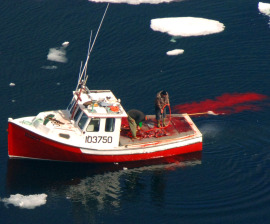Each year, it is estimated that 200,000 seabirds are accidentally snared, entangled and drowned by longline hooks and in trawls, driftnets and gillnets in European waters alone. Seabird bycatch not only poses a significant threat to the survival of many species, but is also an animal welfare problem. Impaled on fishing hooks or suffering from lacerations, broken bones or damaged wings, wounded birds unable to fly will eventually die.
Baited hooks
There are, however, a variety of ways that this suffering and mortality can be prevented. For example, in pelagic longline fisheries, setting lines at night and weighting them to reduce the time that baited hooks are near or on the surface has been found to effectively reduce incidental seabird bycatch. These methods can be used in combination with bird scaring lines, which can also deter seabirds from trying to get food off baited hooks.
In trawl fisheries, seabird mortality tends to be associated with the discharge of waste from vessels. This is because seabirds tend to feed behind the trawlers and collide with cables or get caught up in nets. Research has found that simple measures, such as the onboard retention of waste materials (e.g. offal) can be extremely effective in preventing unnecessary seabird deaths.
Sound—emitting “pingers”
Likewise, in gillnet fisheries, increasing the visibility of nets, adding sound-emitting “pingers” and closing fisheries at certain times has been found to reduce incidental catches of various species. Scientists have estimated that the mortality rate for birds such as divers, grebes, sea ducks, diving ducks, auks and cormorants in gillnet fisheries in the Baltic and North Seas is between 100,000 and 200,000 per annum.
Elsewhere across the globe, seabird bycatch has already been massively and rapidly reduced by the introduction of mandatory mitigation measures. More than a decade ago, the UN Food and Agriculture Organisation (FAO) issued an International Plan of Action for reducing the incidental catch of seabirds in longline fisheries, and has since extended this to cover trawl and gillnet fisheries as well.
Urgent action needed in EU
Although active internationally in the fight to save seabirds as a member of various Regional Fisheries Management Organisation (RMFOs), the European Union has thus far been dragging its heels when it comes to developing its own plan of action to mitigate the impact of fisheries on seabird populations in European waters. Urgent action is need within the EU to prevent the unnecessary suffering and death of seabirds on its own doorstep.
HSI therefore welcomes the recent launch by the European Commission of a consultation on the development of a dedicated EU Action Plan for reducing incidental catches of seabirds in fishing gears. Highlighting the need to protect the welfare of all seabirds—irrespective of whether species are endangered or not—and drawing on our experience with this issue worldwide, HSI has participated in this consultation.
HSI hopes that the EU will take swift action and introduce mandatory measures for EU fisheries to prevent the unnecessary suffering and deaths of hundreds of thousands of seabirds in its waters each year.

















